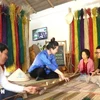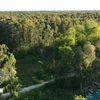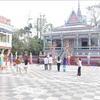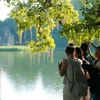 The Con Dao archipelago, located in the southern province of Ba Ria – Vung Tau, is one of Southeast Asia's largest sea turtle protection areas. Bay Canh, an eco-tourism island in Con Dao, is a protected spawning ground for turtles. Sea turtles (Chelonioidea) are listed as rare and endangered animals facing a global risk of extinction, and are being protected by many countries all over the world, including Vietnam. The Southeast Asian country has implemented many programmes and action plans to conserve the reptiles. The Con Dao National Park is the first place in the country to implement a sea turtle conservation programme successfully. (Photo: VietnamPlus)
The Con Dao archipelago, located in the southern province of Ba Ria – Vung Tau, is one of Southeast Asia's largest sea turtle protection areas. Bay Canh, an eco-tourism island in Con Dao, is a protected spawning ground for turtles. Sea turtles (Chelonioidea) are listed as rare and endangered animals facing a global risk of extinction, and are being protected by many countries all over the world, including Vietnam. The Southeast Asian country has implemented many programmes and action plans to conserve the reptiles. The Con Dao National Park is the first place in the country to implement a sea turtle conservation programme successfully. (Photo: VietnamPlus)  About 10 to 20 turtles go on Bay Canh islet to lay eggs each night. Each turtle is 1 metre and above in length. The breeding season for sea turtles is around April to October, with the peak season lasting from June to September. As an important nesting place for two rare marine species - olive ridley sea turtles and hawksbill sea turtles, the Con Dao National Park has 14 beaches where the turtles favour laying eggs, including those on Hon Tai (Tai Islet), Hon Bay Canh (Bay Canh islet), and Hon Tre (Tre islet). Among them, the Bay Canh islet has attracted the most significant number. (Photo: VietnamPlus)
About 10 to 20 turtles go on Bay Canh islet to lay eggs each night. Each turtle is 1 metre and above in length. The breeding season for sea turtles is around April to October, with the peak season lasting from June to September. As an important nesting place for two rare marine species - olive ridley sea turtles and hawksbill sea turtles, the Con Dao National Park has 14 beaches where the turtles favour laying eggs, including those on Hon Tai (Tai Islet), Hon Bay Canh (Bay Canh islet), and Hon Tre (Tre islet). Among them, the Bay Canh islet has attracted the most significant number. (Photo: VietnamPlus)  Turtles which have laid eggs on the islet are attached with an identification tag. Bay Canh islet is a large marine turtle conservation area. It is covered by mangroves with about 5.1 ha, with 24 mangrove species, mainly double mangroves, parrots, lime, guava, and eagle. This islet also has beautiful beaches and incredibly beautiful coral reefs offshore. The Con Dao National Park is the first place in Vietnam to carry out a sea turtle conservation programme successfully. The number of sea turtles laying eggs in Con Dao accounts for about 90% of the total of the sea turtles in Vietnam. The park has 14 beaches where the turtles favour laying eggs. (Photo: VietnamPlus).
Turtles which have laid eggs on the islet are attached with an identification tag. Bay Canh islet is a large marine turtle conservation area. It is covered by mangroves with about 5.1 ha, with 24 mangrove species, mainly double mangroves, parrots, lime, guava, and eagle. This islet also has beautiful beaches and incredibly beautiful coral reefs offshore. The Con Dao National Park is the first place in Vietnam to carry out a sea turtle conservation programme successfully. The number of sea turtles laying eggs in Con Dao accounts for about 90% of the total of the sea turtles in Vietnam. The park has 14 beaches where the turtles favour laying eggs. (Photo: VietnamPlus).  Attaching the identification tags aims to enhance the management and protection of each turtle. Con Dao beaches are nesting sites of the biggest number of green sea turtles in Vietnam. The national park is the country's first to successfully carry out a sea turtle conservation programme, beginning in 1994. It has studied the animals' behaviour and worked out effective conservation measures for Con Dao and beaches nationwide. The number of sea turtles laying eggs in Con Dao accounts for about 90% of the total of the sea turtles in Vietnam. Sea turtles are found to nest on Con Dao island from January to November, with the peak season lasting from June to September. (Photo: VietnamPlus)
Attaching the identification tags aims to enhance the management and protection of each turtle. Con Dao beaches are nesting sites of the biggest number of green sea turtles in Vietnam. The national park is the country's first to successfully carry out a sea turtle conservation programme, beginning in 1994. It has studied the animals' behaviour and worked out effective conservation measures for Con Dao and beaches nationwide. The number of sea turtles laying eggs in Con Dao accounts for about 90% of the total of the sea turtles in Vietnam. Sea turtles are found to nest on Con Dao island from January to November, with the peak season lasting from June to September. (Photo: VietnamPlus)  Turtles often lay eggs in coastal soft sandy areas. The Con Dao National Park is the first place in Vietnam to carry out a sea turtle conservation programme successfully. It has 14 beaches that the turtles favour to lay eggs. The number of sea turtles laying eggs in Con Dao accounts for about 90% of the total of the sea turtles in Vietnam. The breeding season for sea turtles is around April to October, with the peak season lasting from June to September yearly. Protecting the sea turtles is an outstanding success of the park, contributing to the conservation of endangered marine species worldwide. (Photo: VietnamPlus)
Turtles often lay eggs in coastal soft sandy areas. The Con Dao National Park is the first place in Vietnam to carry out a sea turtle conservation programme successfully. It has 14 beaches that the turtles favour to lay eggs. The number of sea turtles laying eggs in Con Dao accounts for about 90% of the total of the sea turtles in Vietnam. The breeding season for sea turtles is around April to October, with the peak season lasting from June to September yearly. Protecting the sea turtles is an outstanding success of the park, contributing to the conservation of endangered marine species worldwide. (Photo: VietnamPlus)  Rangers and staff of the Con Dao National Park are always present to help turtles when they are laying eggs. The eggs are then moved to a safe incubation place. When the tide is high, the mother turtles begin to wander on the ocean waves near the shore to find a place to lay eggs. Mother turtles slowly crawl ashore through the beach in the silver moonlight to find their place. To lay eggs, sea turtles must follow these steps: find the beach, dig a nest, lay eggs, and cover the nest to erase traces. The number of sea turtles laying eggs in Con Dao accounts for about 90% of the total of the sea turtles in Vietnam. (Photo: VietnamPlus)
Rangers and staff of the Con Dao National Park are always present to help turtles when they are laying eggs. The eggs are then moved to a safe incubation place. When the tide is high, the mother turtles begin to wander on the ocean waves near the shore to find a place to lay eggs. Mother turtles slowly crawl ashore through the beach in the silver moonlight to find their place. To lay eggs, sea turtles must follow these steps: find the beach, dig a nest, lay eggs, and cover the nest to erase traces. The number of sea turtles laying eggs in Con Dao accounts for about 90% of the total of the sea turtles in Vietnam. (Photo: VietnamPlus)  The number of eggs each night is explicitly recorded. The number of sea turtles laying eggs in Con Dao accounts for about 90% of the total of the sea turtles in Vietnam. Sea turtles were found to nest on Con Dao island from January to November, with the peak season lasting from June to September. Since 1994 the Con Dao National Park has implemented a sea turtle conservation programme that focuses on researching the ecological characteristics of the sea turtles, protecting nesting habitats and egg nests and building hatcheries. Specific action programmes include wearing satellite locator tags and moving egg nests to a safe place, creating a safe hatching station and inspecting and releasing baby turtles to the sea. (Photo: VietnamPlus)
The number of eggs each night is explicitly recorded. The number of sea turtles laying eggs in Con Dao accounts for about 90% of the total of the sea turtles in Vietnam. Sea turtles were found to nest on Con Dao island from January to November, with the peak season lasting from June to September. Since 1994 the Con Dao National Park has implemented a sea turtle conservation programme that focuses on researching the ecological characteristics of the sea turtles, protecting nesting habitats and egg nests and building hatcheries. Specific action programmes include wearing satellite locator tags and moving egg nests to a safe place, creating a safe hatching station and inspecting and releasing baby turtles to the sea. (Photo: VietnamPlus)  On average, each turtle lays between 80 and 150 eggs, with a hatching rate of over 80%. The characteristic of turtles is to lay eggs at night. The breeding season for sea turtles is around April to October, with the peak season lasting from June to September yearly. During the night, the mother turtles go to the beach to choose a delicate sand area near the groves, use the two front fins to dig their nests about 60 - 80cm deep depending on the mother's size, and start to lay eggs. To lay eggs, sea turtles must follow these steps: find the beach, dig a nest, lay eggs, and cover the nest to erase traces. (Photo: VietnamPlus)
On average, each turtle lays between 80 and 150 eggs, with a hatching rate of over 80%. The characteristic of turtles is to lay eggs at night. The breeding season for sea turtles is around April to October, with the peak season lasting from June to September yearly. During the night, the mother turtles go to the beach to choose a delicate sand area near the groves, use the two front fins to dig their nests about 60 - 80cm deep depending on the mother's size, and start to lay eggs. To lay eggs, sea turtles must follow these steps: find the beach, dig a nest, lay eggs, and cover the nest to erase traces. (Photo: VietnamPlus)  Eggs are moved to a safe incubation place. The characteristic of turtles is to lay eggs at night. During the night, the mother turtles go to the beach to choose a fine sand area near the groves, use the two front fins to dig their nests about 60 - 80cm deep depending on the mother's size, and start to lay eggs. After completing the nest, the mother turtle uses the front fin to fill it with a length of 5-6 m to erase traces and camouflage from its nests. The average mother turtle lays about 80 eggs, but there are also cases of more than 200 eggs in Con Dao. (Photo: VietnamPlus)
Eggs are moved to a safe incubation place. The characteristic of turtles is to lay eggs at night. During the night, the mother turtles go to the beach to choose a fine sand area near the groves, use the two front fins to dig their nests about 60 - 80cm deep depending on the mother's size, and start to lay eggs. After completing the nest, the mother turtle uses the front fin to fill it with a length of 5-6 m to erase traces and camouflage from its nests. The average mother turtle lays about 80 eggs, but there are also cases of more than 200 eggs in Con Dao. (Photo: VietnamPlus)  Turtles' eggs will hatch after about 50 days. While waiting for the mother turtle to leave the nest, the rangers perform their conservation work, taking the eggs to an incubator. Eggs are incubated for six hours before being transferred to a sanctuary. When returning, half of the eggs will be placed in a strong-lit sand pool, and the other half in a covered sand pool. This balances the "gender" for baby turtles because it is decided by the light and temperature when hatching. Since 1994, the Con Dao National Park has implemented a sea turtle conservation programme that focuses on researching the ecological characteristics of the sea turtles, protecting nesting habitats and egg nests and building hatcheries. (Photo: VietnamPlus)
Turtles' eggs will hatch after about 50 days. While waiting for the mother turtle to leave the nest, the rangers perform their conservation work, taking the eggs to an incubator. Eggs are incubated for six hours before being transferred to a sanctuary. When returning, half of the eggs will be placed in a strong-lit sand pool, and the other half in a covered sand pool. This balances the "gender" for baby turtles because it is decided by the light and temperature when hatching. Since 1994, the Con Dao National Park has implemented a sea turtle conservation programme that focuses on researching the ecological characteristics of the sea turtles, protecting nesting habitats and egg nests and building hatcheries. (Photo: VietnamPlus)  Overnight tours have been organised to allow visitors to watch turtles laying eggs on Con Dao island. Rangers directly guide the tours to ensure they do not impact turtles laying eggs. The Con Dao National Park is the first place in the country to implement a sea turtle conservation programme successfully. Since 1994 it has implemented a sea turtle conservation programme that focuses on researching the ecological characteristics of the sea turtles, protecting nesting habitats and egg nests and building hatcheries. Specific action programmes include wearing satellite locator tags, moving egg nests to a safe place, creating a safe hatching station, and inspecting and releasing baby turtles to the sea. (Photo: VietnamPlus)
Overnight tours have been organised to allow visitors to watch turtles laying eggs on Con Dao island. Rangers directly guide the tours to ensure they do not impact turtles laying eggs. The Con Dao National Park is the first place in the country to implement a sea turtle conservation programme successfully. Since 1994 it has implemented a sea turtle conservation programme that focuses on researching the ecological characteristics of the sea turtles, protecting nesting habitats and egg nests and building hatcheries. Specific action programmes include wearing satellite locator tags, moving egg nests to a safe place, creating a safe hatching station, and inspecting and releasing baby turtles to the sea. (Photo: VietnamPlus)  Organising overnight tours for visitors to watch turtles laying eggs is expected to be an effective communication channel for environmental protection, especially the protection of marine turtles. Sea turtles are listed as rare and endangered animals facing a global risk of extinction, and are being protected by many countries worldwide, including Vietnam. The Con Dao National Park in southern Ba Ria - Vung Tau province is the first place in the Southeast Asian country to implement a sea turtle conservation programme successfully. Con Dao is one of the places that domestic and international tourists visit and participate in the sea turtle conservation programme. (Photo: VietnamPlus)./.
Organising overnight tours for visitors to watch turtles laying eggs is expected to be an effective communication channel for environmental protection, especially the protection of marine turtles. Sea turtles are listed as rare and endangered animals facing a global risk of extinction, and are being protected by many countries worldwide, including Vietnam. The Con Dao National Park in southern Ba Ria - Vung Tau province is the first place in the Southeast Asian country to implement a sea turtle conservation programme successfully. Con Dao is one of the places that domestic and international tourists visit and participate in the sea turtle conservation programme. (Photo: VietnamPlus)./. VNA



















